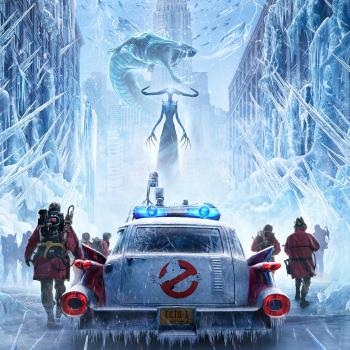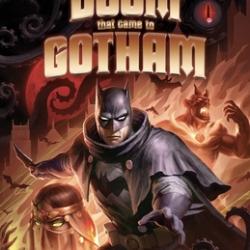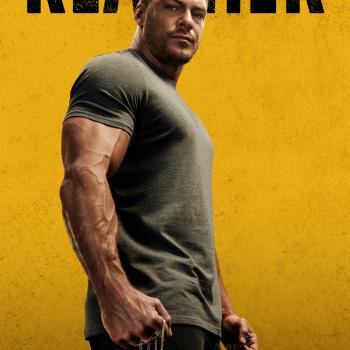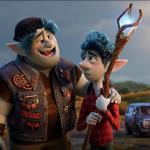A Review of Cloud Atlas, directed by Tom Tykwer and Wachowski Starship
By ALEXIS NEAL
Every once in a while, you see movies advertised as offering ‘something for everyone,’ and it’s usually just so much marketing malarkey. Cloud Atlas is an exception. This deeply strange film includes: a period adventure on the high seas (complete with abolitionist sub-plot); a tragic Gothic love story full of secrecy and betrayal; a 1970’s conspiracy thriller; a screwball madcap comedy caper; a dystopian sci-fi tale of oppression, rebellion, and star-crossed lovers; and a tribal struggle set in a Planet of the Apes future. These six stories are interwoven into a single, unique (albeit rather long) film. It is truly one-of-a-kind.
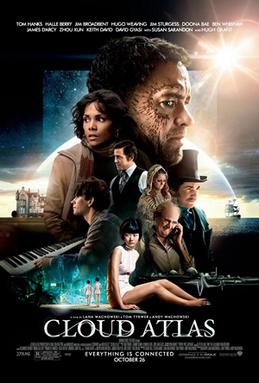
But as I listened to various characters pontificate about vaguely philosophical ideas, I couldn’t shake the feeling that Cloud Atlas is perhaps laboring under the misapprehension that it is deeper and more important than it actually is—the sum of all wisdom, perhaps, or the answer to Life, the Universe, and Everything.
As such an all-important film, it falls flat. But taken as an interesting experiment—the telling of six tales as one—executed with skill and dexterity, it is by no means unsatisfactory. It is even enjoyable (if occasionally confusing), and I must confess that it felt like a much shorter film that it was (it clocks in at a hefty 161 minutes).
The filmmakers rely on a fairly small stable of actors, each of whom does double, triple, or quadruple (even quintuple or sextuple) duty across the six stories, and they chose their cast well. It is a joy to see skilled actors inhabit such a wide range of characters in a single work, particularly when they are clearly having such a good time with their roles (see, e.g., Tom Hanks as a thug-cum-author, and Hugh Grant, Hugo Weaving, and Jim Broadbent across the board). This was my first exposure to James D’Arcy, who brings a certain quiet wistfulness to each of his roles. I found myself liking those he likes simply because he likes them (even when those he likes are utterly unlikable). Jim Sturgess, another newish face to me, is serviceable and sympathetic as an ailing young lawyer aboard a ship in the mid-nineteenth century, but really shines as the selfless rebel captain who handles the terrified fabricant/clone with gentle kindness but who, as it turns out, also kicks a fair amount of totalitarian behind. And I swear Susan Sarandon gets more luminous with every passing year. But the real stars are arguably the makeup artists, who certainly earned their keep (and probably an Oscar nomination, if not an outright win), skillfully distinguishing the various characters played by each actor and often crossing ethnic lines with surprising success (with the exception of their attempt to turn Doona Bae into a be-freckled Southern belle).
The stories themselves are told well, and any one of them would make an excellent film in its own right. The connection between the stories is, however, rather tenuous. They are not only disparate in style and setting; they are disparate in substance (despite a recurring birthmark that Wikipedia tells me was meant, at least in the book, to signal a single soul’s reincarnation across time, a theme that is never clearly developed in the film). Of course, the filmmakers (and the original novelist) undoubtedly think the stories are connected in some deep and meaningful way, and perhaps they are. The stories, though distinct, do share thematic similarities. In interviews, the filmmakers (and actors) have cited as central the idea that we are all connected to one another across time, and our actions and choices reverberate through history. (This theme is echoed on a practical level by the physical passing of the stories from plot to plot. Each story is documented in some way (in journals, correspondence, etc.) and passed on to the actors in the next story, whose story is then documented and passed along again.) So, ok, there are connections and the movie certainly has Things To Say.
For the Wachowkis, the unifying theme of the stories is a sense of community and human connectedness. I was struck, however, by the portrayal of injustice as a universal experience. In each story, an injustice is being committed, and in each story, the characters involved must decide how to respond to that injustice. Some characters choose selfishness; others engage with circumstances in an attempt to bring about justice. So the fabricant/clone, when confronted with the horrible fate inflicted en masse on others like herself, chooses to take a stand in defense of those whom society as deemed ‘less than human’ and thus undeserving of basic human rights, or even life itself.* This decision proves costly, yet the film clearly embraces the sacrifice of self for the pursuit of justice as honorable and right. This idea of self-sacrifice for the sake of justice recurs across several story lines—a young lawyer helps an escaped slave; a freedom fighter saves a helpless girl; a man risks his life to help the daughter of a friend; a woman risks her life for truth and to save thousands, perhaps millions; and a man undertakes a dangerous journey in exchange for a cure for a sick girl. In two of the story lines, this theme is rather muddled, as the victim and the savior are the same person, and, in one story, the perceived solution to the injustice is apparently self-salvation through suicide.
Regardless of whether we agree with the means used to combat injustice—or even with the filmmakers’ characterization of certain events and actions as unjust—this experience of injustice makes an excellent theme, for it is common to all. If there is any universal constant in a fallen world, it is injustice. As Christians, we know this, not only from our own experience, but because of what we read in Scripture. Evil men prosper, and righteous men suffer. (Psalm 73; Jeremiah 12:1-4; Job) This is a function of the sin that has tainted and poisoned the world since the Fall. (Genesis 3:17-19; Romans 8:20-22) But what are we to do about it? Why should we care about the injustices endured by others? Why should we expect their help when we are ourselves victims of injustice?
We know that God is just—in His character and His actions. (Deuteronomy 32:4; Psalm 33:5; Psalm 140:12; Revelation 15:2-4) Sometimes, this is a comforting thought. After all, God promises to punish those who seem to get off scot-free in this life. (Nahum 1:3) Because He promises to execute final justice in the end, we can trust Him while we endure injustice in this life. But for sinners like us, this justice can also be a terrifying thought—if no sin goes unpunished, we are in deep, deep trouble. If God wreaks justice upon us, we are doomed. Yet justice is not God’s only attribute. He is also loving and merciful, and His perfect justice is tempered by that love and mercy. So despite our sin, and the eternal punishment we earned thereby, He sent His own Son to bear the penalty in our place. In this gospel, we see perfect love and perfect justice united in self-sacrifice. (Romans 3:22-26)
As Christians, we are to emulate this aspect of His character. Like the more admirable characters in Cloud Atlas (and there are several), we are to seek justice—to defend the defenseless, to protect the weak, to sacrifice ourselves for others. (Proverbs 18:5; Proverbs 29:7; Isaiah 1:17; Micah 6:8; Matthew 23:23) The justice we seek, however, like the justice of God Himself, is to be tempered with mercy. We are to seek justice, yes, but more than that, we are also to love our neighbor, even laying down our lives for others. We sacrifice ourselves for others, even when those others do not deserve it, because God sacrificed for us when all we deserved was eternal damnation. (Deuteronomy 24:17-22; Luke 10:25-37; John 15:13; Galatians 5:14) We love because He first loved us. (I John 4:19) Our belief in and gratitude for the gospel is what drives us to love others and seek justice on their behalf, and this motivation is—or should be—stronger than any mere ‘human connection across time’.
*While it is by no means a central theme in the film, I was struck by the (likely unintended) parallels between the fate of the fabricants/clones and the tragic reality of abortion. These fabricants are manufactured and destroyed at will, and the film is clear that the mass slaughter of these ‘sub-human’ creatures is both horrifying and reprehensible. The heroine of the story—a fabricant/clone herself—proclaims repeatedly that people are connected to one another ‘from womb to tomb’, arguably implying, that people in the womb are, in fact, people. (Whether this is deliberate allusion to West Side Story is unclear.) As I said, I don’t think this was an intended parallel, so it’s not the focus of my review, but it is still worth noting.
_______________________________________________________________
Alexis Neal is an attorney in the Washington, D.C., area. She regularly reviews young adult literature at www.childrensbooksandreviews.com and everything else at quantum-meruit.blogspot.com.



